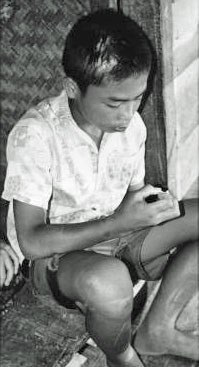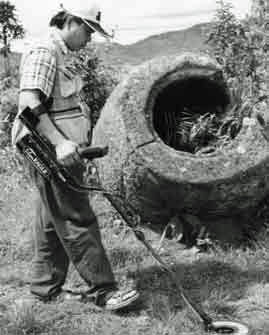Laos & Vietnam Flowers to be Grown on the Former BattlefieldsAugust 1999
The first year of the tourism era in Laos
Peace came to Indochina,the forefront of the Cold War between the East and the West,but strategic aid that had been given because of the cold war came to the end at the same time. Therefore, Laos, Vietnam and Cambodia have to carry out economic development by their own efforts harder than before. The elite of those countries who were studying in the East in expectation of a bright future have to carve out a new course of their lives with new values. Laos, which had been noticed least of the countries, started to make self-help efforts. The Lao government is trying to find a means of economic development in tourism, setting this year and the next year as “Visit Laos Years.” To see the present state of Laos, I visited a man, who used to be the elite and now is engaged in the development of the remains in the Plain of Jars.
Still on a war footing even after the war ended

“I want to be as healthy and normal as before,” said a boy with his head down over his paralyzed left arm. A part of his skull on the right side was lost, so his pulsating blood vessels could be seen through.
Here is Napa Village in Xieng Khouang Province about 370 km north of Vientiane, the capital of Laos. Tanun Sai (13) was injured by a dud three years ago. When he was catching insects with his friends in a rice field, he found a tennis ball-sized iron ball. It was a bomblet called “bombi.” A bombi is designed to explode on impact. But Tanun didn’t know that. When he played with it, it hit him on the head and exploded. He was so badly injured that his brain was exposed. He was taken to a hospital in Vientiane and saved from death. However, he has been paralyzed on the left side of his body and retarded mentally. He had to repeat two years in elementary school and barely moved up to the fourth grade. In this province seven children were killed by duds last year.
Xieng Khouang Province was a birthplace of the Lao Communist Party and the Ho Chi Minh Trail, a supply route of weapons and ammunition, passed through this province, so that the U.S Amy made carpet-bombing attacks repeatedly on this area. Duds and booby traps at that time have been still buried densely even now, 20 years after the end of the war. It is said that the U.S. Amy dropped 1,500,000 tons of bombs on Laos during the second Indochinese War.
The Pathet Lao (Lao Patriotic Front), the predecessor of the Lao Communist Party, defeated France, which had not approved of independence, and managed to establish a coalition government by Phouma. But the civil war with pro-American forces was resumed. The U.S at cold war with Soviet intervened the civil war to check the spread of communism, trying to block the Ho Chi Minh Trail, which went through the liberated area of Pathet Lao to the Mekong Delta, because the trail made the tide of the war situation in Vietnam against the U.S. Army.
Tanun’s medical expenses were paid by an American non-governmental organization, but he will never be as healthy and normal as he used to be. His mother found five bombies three days ago in the rice field where Tanun was injured and asked the village office to dispose of them. There is no battle now, but there is always a victim like Tanun as long as duds and booby traps remain.
A detector sounds continuously

The Plain of Jars is famous for its mysterious jars. However, duds are buried more densely, because there was a frontline base in the jar site, so that the place was raided as a target of aerial bombing.
Poo, poo, pooh-poo, poo. The dry sound of a metal detector went off continuously when Sousath moved the detector slowly between jars on the red earth. Sousath Phetrasy (39) runs a hotel, while he has worked at disposing of duds since nine years ago. His dream is to make these remains a representative tourist attraction of Laos. There is a big crater with a diameter of 10 meters on a gentle slope. The crater was made by explosion of a 250 kg bomb. Jars around the crater were broken and fell down. Suchart’s detector kept on sounding, detecting fragments of bombs, duds and bullets used at ground battles.
Usually about one kilogram of arms is detected. Half of them are bullets and 20 % are dangerous duds. “This work requires strong powers of concentration. But I can do it because I was a soldier for three years.” Today, he found the remains of a burst napalm bomb, unused bullets for American M16 rifle and metal parachute fittings.
Farmers’ side income

At the porch of a farmer’s house, an old woman was working at a spinning wheel. “Unlike wooden pillars they are so strong that we don’t have to replace them,” she mentioned about the bomb shells 1m long that were used as posts to support her above-ground style house. Weapons are diverted to many different purposes. The villagers use them as a gatepost, a fence, a well bucket, a manger, cooking utensils and so on. You can see them everywhere in the village.
As I went along the Ho Chi Minh Trail, I saw some scrap-iron dealers who had a pile of the remains of wrecked tanks and planes. Although a quarter of a century has passed after the war ended, a large quantity of the remains is still being found, which indicated how fierce the battle in this place was. Some farmers were here to sell their today’s ‘take’ of scrap. Suri (33) put a muddy machine gun on a scale and received 2,000 kip (about 120 yen) for it. He said, “I look for scrap from morning till evening when I’m free from farm work. I can draw an income only from this.”
Former weapons are now only scrap metal here. A kilogram of iron is sold for about 85 yen, a kilogram of aluminum for about 900 yen and a kilogram of copper for about 1,800 yen. Even a bombi is salable. As mentioned above, Tanun was badly injured by a bombi. In a bombi many iron balls were set to enhance the killing power. A small iron ball in a bombi is sold at a high price of three yen each, because the ball as is can be used as a bearing of a motorbike. “But to sell a bombi, you should take the balls out, because it’s dangerous.”
The farmers cannot do farm work for half a year because there are no irrigation facilities, and crops don’t grow in many fields because of defoliant sprayed by the U.S. Army. The average annual income per capita in this country is about 30,000 yen. This side income brought by a negative legacy is very precious to the farmers.
Making the negative legacy a tourist attraction

Sousath not only removes arms from the sites but also collects broken weapons by buying them from scrap-iron dealers. “These all will be sold to the government as scrap. I’d like to keep them and show children what a war is like.” He has a plan to exhibit them in a hotel room. Also, he wants to build a war museum in the future.
As the logo mark with a design of flowers and ethnic musical instruments of the Lao tourism years indicates, the features of this country are verdurous nature and as many as nearly 50 ethnic cultures. However, Senruan Ponmawanser (52), the assistant chief of the commercial and tourist bureau in Xieng Khouang Province thinks of the scars of the war as a tourist attraction.
He said, “We cannot talk about this country without the Indochina war. We are going to keep the remains of the war and show our next generations and tourists that war is never good.” Like Suchart is planning, the bureau is also gathering tanks, cannons and duds to exhibit them.”
“Not grave-posts but flowers”
Sousath was born a son of a leader of the Communist Party. His boyhood was in the midst of the war, so he had to live in a cave to avoid fire and sword. He studied economics in East Germany for six years, and then he became an elite clerk of the Central Bank, but he retired the bank, because he became distrustful of bureaucracy and socialism at their corruption. Later, when he was a reporter of a radio station, he bought a metal detector from a former American soldier. At first he cooperated in searching missing soldiers and treasures that they say the Central Intelligence Agency (CIA) hid. However, only one identification tag was found, while surprisingly a great number of duds were found.
“At that time I supported the liberation movement. But looking back on those days, I think the disasters of war over a period of 30 years were too high a price to pay for liberation. I thought if the former ruling regime lasting from the colonial period was overthrown and the socialist government was established, our country would develop soon, but …,” he remarked. It was, however, in 1986 that the Lao government adopted the open policy, and up to that time as many as 400,000 people equivalent to a tenth of the population had taken refuge abroad just like many of Vietnamese fled their own country. Sousath decided to develop the land into a land that will yield treasure in the future, not to search the land for treasure of the past with a metal detector. He proposed a project for disposing of duds and constructing paved roads and information centers to the United Nations, and 200,000 dollars were brought in to the province. He has since continued to dispose of duds at his own expenses. As a result, three out of 13 sites in the Plain of Jars are safe for sightseeing now. The number of hotels in this province has increased to 16 and the number of rooms to 381 in total. The local paper Vientiane Times said in its front page in April of this year, “The tourist industry comes out tops in foreign- exchange earnings.” The number of tourists exceeded 500,000 last year and the foreign money the tourist industry obtained amounted to 79,900,000 dollars. The year before last the tourist industry ranked fourth following the textile industry, the lumber industry and the jewelry industry, but it jumped to the top this year.
He abandoned his position as a high official to devote half his life to tourist development. He spoke his mind to me. “After the war, nothing but poverty and devastated land was left behind in this country. I want to plant flowers in this place not grave-posts.” The national land is as big as the main island of Japan, but it is mountainous and its population is only about five million. The conditions are not suitable for launching a plantation or a labor-intensive industry. The communist government started to promote the open economy and the world started to show a tendency to appreciate nature and cultures. I think Sousath, who is staking his life on tourism, is still a leader who bears the fate of Laos on his shoulders, even though the time has changed.
The price for tourist development — A popular writer Bounthanong Xomxayphol talks
The open economic policy itself is not a bad policy. For instance, the TV broadcasting of the National Assembly in session stimulates Laos in a good sense. People started to voice their opinions of dictatorship by the Communist Party, though they say weakly.
But we shouldn’t forget that everything has two sides. Although the tourist industry is being a key revenue source, it may shake our culture and tradition to their foundations at the same time.
Everyone wants to live an easy and pleasant life. So goods are flowing increasingly into the country. As a result Laos will be affected immensely. On the other hand, tourists visit this country to rediscover what they have lost. I think they want to make sure of their own identity. Laos has been changing dramatically. It will be not very long before Lao people reflect on what has been important to them.

